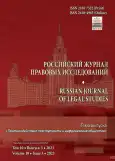The Most Common Type of Political Regime under Capitalism
- Authors: Kerimov A.D.1
-
Affiliations:
- Institute of State and Law of the Russian Academy of Sciences
- Issue: Vol 10, No 3 (2023)
- Pages: 31-40
- Section: Public law
- URL: https://journals.rcsi.science/2410-7522/article/view/253465
- DOI: https://doi.org/10.17816/RJLS552000
- ID: 253465
Cite item
Abstract
In this article, the author proposes that the most common type of political regime lies beneath the dominance of capital plutocracy. The author differentiates opposing trends in specific actions taken by various factions of the ruling class to define their value orientations. The article focuses on the pro-Western fifth column, a prominent class in our country, comprising individual representatives of power structures and open-minded professionals, while expressing full support for a part of the domestic establishment (headed by the President of the Russian Federation, Vladimir Putin) and the associated patriotic intelligentsia whose aim is to comprehensively revive Russia’s power. At the same time, the author believes that the mobilization of all institutions of the state and society is necessary to defeat the collective West, a feat that is only possible by upholding the fundamental foundations of capitalism.
Keywords
Full Text
##article.viewOnOriginalSite##About the authors
Alexander Dzh. Kerimov
Institute of State and Law of the Russian Academy of Sciences
Author for correspondence.
Email: 8017498@mail.ru
SPIN-code: 7041-9829
doctor of law, professor, chief researcher
Russian Federation, 10, st. Znamenka, 119019 MoscowReferences
- Panarin AS. Global’noe politicheskoe prognozirovanie v usloviyakh strategicheskoi nestabil’nosti. Moscow: Editorial URSS; 1999. (In Russ.).
- Marks K, Engel’s F. Manifest Kommunisticheskoi partii. Moscow: Politizdat; 1970. (In Russ.).
- Bagaturiya GA. Kontury gryadushchego. Izbrannye proizvedeniya. Moscow: Izdatel’stvo Moskovskogo universiteta; 2014. (In Russ.).
- Tolstoi LN. Polnoe sobranie sochinenii. T. 45. Put’ zhizni. 1910. Moscow: Gosudarstvennoe izdatel’stvo khudozhestvennoi literatury; 1956. (In Russ.).
- Ortega-i-Gasset Kh. Vosstanie mass. Moscow: Izdatel’stvo AST; 2020. (In Russ.).
- Necresov NA. Stikhotvoreniya NA. Nekrasova. Posmertnoe izdanie. T. III. Saint Petersburg: Tipografiya M.M. Stasyulevicha; 1879. (In Russ.).
- Petrov PP, Berlin YaV. Aforizmy: po inostrannym istochnikam. Moscow: Progress; 1985. (In Russ.).
- Berdyaev NA. Sud’ba Rossii. Opyty po psikhologіi voïny i natsіonal’nosti. Moscow: Izdanie G.A. Lemana, S.I. Sakharova; 1918. (In Russ.).
- Kirill, Patriarkh Moskovskii i vseya Rusi. Sem’ slov o russkom mire. Moscow: Vsemirnyi Russkii Narodnyi Sobor; 2015. (In Russ.).
- Kirill, Patriarkh Moskovskii i vseya Rusi. Slovo o traditsii i sovremennom obshchestve. Moscow: Vsemirnyi Russkii Narodnyi Sobor; 2016. (In Russ.).
- Nitsshe F. Veselaya nauka. Zlaya mudrost’. Moscow: Eksmo; 2008. (In Russ.).
- Berdyaev NA. Dukhovnoe sostoyanie sovremennogo mira. Put’. Organ” russkoi religioznoi mysli. 1932;(35). (In Russ.).
- Saltykov-Shchedrin ME. Sobranie sochinenii. T. 7. Moscow: Khudozhestvennaya literature; 1969. (In Russ.).
- Toinbi ADzh. Postizhenie istorii. Moscow: Airis-press; 2010. (In Russ.).
- Panarin AS. Rossiya v tsiklakh mirovoi istorii. Moscow Izdatel’stvo MGU;1999. (In Russ.).
Supplementary files






